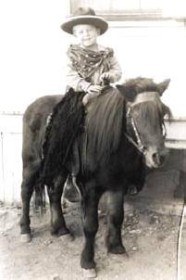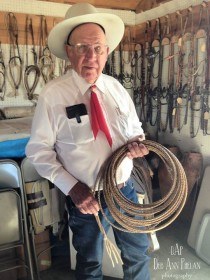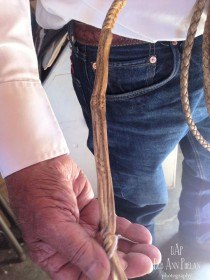Ernie Morris and a Vaquero History ~
Posted by Deb Ann Phelan Buckaroo Traditions on facebook April 24, 2015
As Blanche Morris and I were going over this article with a finely toothed comb, I finally asked if Ernie liked the piece. She said, “Yes, very much, it is deep though.” I will agree wholeheartedly; there is a lot to digest here. As a writer laboring under the assumption that everyone knows the basics, I had picked up the reins in the middle of the history of the Vaquero. Many requested a complete version of events rather than an abbreviated glimpse. Somewhere near the fourth rewrite, the decision to go “all in” became the goal and even now, the following is an abridged version.
Meeting Ernie and his lovely wife Blanche in Paso Robles, in the early 1980’s, brings back fond memories. In the following years, our paths would cross with a smile and a nod of acknowledgment. On a warm June 19, 2013, at their Templeton ranch, we met for a brief 7-hour, working interview. Blanche had joined us briefly before she was off to volunteer at the local hospital for the day. We covered a lot of ground in June, and it has taken awhile to figure out exactly where to start. Since the Vaquero is so key to the Ernie Morris we know, this piece begins…at the beginning.
Origins of the Vaquero…
The tradition of the Vaquero was born in the Iberian Peninsula, in southwestern Europe, specifically Spain, Portugal, Andorra, the south of France and the British Territory of Gibraltar. The main contributions to the Vaquero came from the Spanish, who were well-accomplished horsemen and expert herdsmen. The origins of the Vaquero began in Spain with the large, self-sustaining Spanish estates.Raising livestock was vital to ranching haciendas, and most raised enough stock to supply their own needs. This style of cattle ranching, later imported to the Americas, was found throughout much of the Iberian Peninsula due to dry climates, sparse feed, and large herds.
In 710 AD when the Moors invaded the Iberian Peninsula from the north coast of Africa, a five-mile voyage at its closest point, they brought experienced equestrians, and master rawhide braiders. They also brought the art of the twisted hair rope, a technique learned from the Egyptians. During the 782 years of Moorish occupation, the Spanish merged these skills with their own and became supreme equestrians with superior equipment.
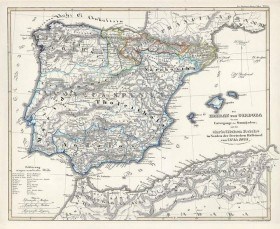 Iberian peninsula, Emirate of Cordoba 711-1028, published 1846. (Courtesy Ancestry Images)
Iberian peninsula, Emirate of Cordoba 711-1028, published 1846. (Courtesy Ancestry Images)
Expanding the Spanish Empire…
In 1492, the Catholic Monarchs, Queen Isabella I of Castile and King Ferdinand II of Aragon, finally ejected the Moors. The Spanish then set their sights on expanding their empire to conquer new lands and acquire more riches. In that same year, Ferdinand and Isabella sponsored Christopher Columbus on the first of his four voyages. In his quest for a route to India, he set sail on August 3, with 90 sailors and 3 ships: the Niña, the Pinta and the Santa Maria, which was captained by Columbus himself. On October 12, 1492, he made landfall on San Salvador in the Bahamas. Soon thereafter, Cuba and several of the surrounding islands became Spanish territories, setting the stage for further expeditions westward.
The Spanish Conquer The New World…
In early 1519, Cuba became the starting point for an expedition led by Hernando Cortes. He sailed westward in hopes of discovering more land for the Spanish Empire. Upon his arrival in Mexico, a hostile Aztec nation greeted Hernando Cortes. The Catholic Church awarded the lands of New Spain, to the Spanish Crown with the directive that the Crown would convert the pagan inhabitants to Catholicism. While Cortes founded the colony of New Spain on November 8, 1519, it would be 22 months until the Aztecs were finally defeated. Following the conquest of the Aztecs in 1521, the Spanish settled Mexico and eventually California. It was Hernando Cortes who introduced the men and horses that would become the foundation of the California Vaquero.
The Mission Era…
By 1769, the Spanish began colonizing Alta California and the Mission era began. Since the Catholic Church considered the Native American Indians to be subjects of the Crown, it became the duty of the Padres to convert the Indian population to Christianity. Teaching the Indians skills such as farming and tending the Mission herds, helped aid the Spanish in their colonization endeavor. There remain conflicting reports on the percentage of Spanish descendants, Mexicans, and Indians who would ultimately become the first California Vaqueros.
The First Cattle Drive…
Until the De Anza expedition all livestock transported to California, was solely by ship. During this period, travel from Mexico to California involved a long sea voyage against prevailing winds and ocean currents. Leading the first overland introduction of herds into California, Juan Bautista de Anza Bezerra Nieto and a California Indian guide named Sebastian Tarabal, completely changed the methods of transport and handling of livestock. Discovery of a land route allowed cattle drives north into California rather than transporting by ship.
On October 23, 1775, the De Anza expedition consisting of 30 families with 115 children, escorted by ten veteran soldiers from the Tubac Presidio began the first long distance cattle drive. Departing Mexico and traveling north into current day Arizona, they set out with 695 horses and mules, and 335 head of cattle. From there they veered westward near Tucson, forded the Colorado River, briefly dipping into Baja California before finally heading north into California and ultimately to the San Francisco Bay. While most of the livestock was lost in a mass stampede, the De Anza expedition remains historically important because it established the first overland route for the introduction of livestock into California by the horsemen who were the precursors to the California Vaquero.
The Heyday of the Vaquero…
On September 16, 1810, the struggle for Mexican independence from Spain began. It would result in a 10-year armed conflict through which Mexico and part of current-day California became independent from Spanish rule. By 1830, there was considerable pressure from within Mexico to close the Missions thereby ending the rule of the Catholic Church. The Missions were secularized, and the land was distributed, the majority by land grant. After the secularization of the Missions, the era of the large ranchos began and thus the heyday of the Vaquero.
Historically, the Rancho period dates from 1834 to 1849, the beginning of the gold rush in California. In 1846, the Bear Flag Revolt occurred, led by a small group of American settlers. On September 9, 1850, California became the 31st State of The Union.
The men who were the most accomplished horsemen tending the large herds of cattle on the ranchos became the first California Vaqueros. Ernie spoke at length on the importance of listening, watching, and learning. He explained, “The Vaqueros of old did not readily share information with each other on horsemanship and training techniques.” This competitive camaraderie made learning new skills difficult for young upcoming Vaqueros. Ernie remarked, “Sometimes the information they received would be misleading or false altogether.” Where then, did the responsibility lie for teaching young Vaqueros? Ernie said, “It was up to each individual to figure things out for himself.” The consequences were significant since the Vaqueros would not teach the young, inexperienced horsemen, the results were dire. Accidents, injuries, and even death to both man and beast were not uncommon. Ernie added, “The men that became accomplished Vaqueros under the ‘old system’ were the ones who could learn from anybody, they kept their eyes open and their mouths shut.”
The Vaquero took great pride in his horsemanship and his gear. It is well established the Vaquero possessed expert skills as a horseman. Another unique characteristic in the Vaquero’s range of skills was handcrafting all of the equipment he used, a tradition that continues today. From these men, most significantly came the spade bit. The Vaquero also made his spurs, rawhide hackamores, bosalitos, reins, hobbles, quirts and various braided buttons and knots used as practical adornments as well as twisted horsehair ropes or mecates. Rawhide braiding and twisted horse hair mecates were just two of the important contributions integrated into the Spanish culture when the Moors first occupied Spain. The practice of decorating the saddle with ornate carving and stamping derives from the Mexican Vaqueros. The California Vaqueros used little silver during this time because of the expense and the added weight.
As the years have passed, so with them have the original Vaqueros. At a critical point in the late 1800’s, the era in which Ernie’s grandfather Jesse was an accomplished Vaquero, the dwindling remnants of these exceptional horsemen began to realize that when they died, a way of life would die with them. Ernie commented, “They recognized the unwillingness to share was driving the Vaquero to extinction.” Some would consider these Vaqueros traitors to a way of life shrouded in closely guarded secrets. Ernie considers them resolute and loyal to their craft. He has experienced both sides of this quandary and today he is willing to share his knowledge with those who are willing to listen, and who are dedicated to learning the traditional Vaquero ways. The California Vaqueros who shared were true visionaries; we have them to thank for the difference between reading about the well-made bridle horse and riding one.
Family History in part…it was a large family!
Ernie Morris is a 5th generation Vaquero/Buckaroo on both sides of the family tree. In his early ranching days, a young Ernie worked along with many of the older Vaqueros including his grandfather, the late Jesse Wilkinson. These early lessons would become a foundation for a lifestyle with deep roots to the early California traditions.
His grandfather on his mother’s side was Jesse Wilkinson. Jesse was born in La Graciosa near present day Orcutt, California in 1882. He left the fourth grade to work for the storied cattle company of Miller and Lux. Here he began as a working cowboy and forged his way to the top as a foreman and expert horseman. He also began a life-long love with the art of fine rawhide braiding. Here he learned to make all of the necessary refinements starting with picking the right hide for the project at hand. Jesse passed in 1965 and 50 years later, he remains a well-known and highly respected Vaquero.
In1888, Ernie’s maternal grandmother Nora Ethel Jobe was the first non-Native American born in Carrizo Plains in southeastern San Luis Obispo County, California. Her father Samuel S. Jobe, a Pony Express rider and stagecoach driver was born in 1841 in Anderson, Missouri. Nora’s mother Elizabeth Blackburn was born in Wayne, Missouri in 1851. Jesse Wilkinson and Nora Ethel Jobe were married in 1909. They had four children: Jessie Eliza, born in 1910, Irma L., born in 1912, Charles Benjamin, born in 1914 and Samuel Westcott Wilkinson, born in 1915. Their first-born child, Jessie Eliza Wilkinson, married Donald Arthur Morris on January 27, 1927. On December 13, 1927 the small town of Fellows, Kern County, California welcomed Ernest A. Morris into the world. His sister Clara arrived about two years later.
A young Ernie Morris~
Ernie spent his youth on the family ranch until the age of 12 when the family moved to Paso Robles after the untimely loss of his father in 1940. He has always had a love of horses; during high school, he began working on the cattle ranches around the Paso Robles area. Ernie set his sights on learning the California Vaquero style of horsemanship. From an early age, he was also drawing horses and cattle; the things that came naturally to him were the most important in his life. The Vaquero way would become the foundation for his rawhide braiding, his artwork, and a life well lived.
On March 10, 1954, Ernie married his bride and best friend Blanche. If you have spent any time with this couple, you know what a great partnership it is! With Blanche’s encouragement in 1964, Ernie became a full-time artist, and in 1967, a small hackamore beside the signature on his artwork became a symbol to connect his art and his rawhide work. While the “budding professional artist” was hard at work, so too was Ernie Morris the rawhide braider. His grandfather Jesse Wilkinson had agreed to teach him the art of rawhide braiding if Ernie would agree to follow these two rules, “Do what I tell you and never cheat the public.” It may be too soon to call, but it seems Ernie Morris has held up his end of his grandfather’s request.
Blanche and Ernie Morris on a cold December 13, 2013, Ernie’s 86th birthday. ~
His artwork covers a vast array of subjects in a wide variety of mediums including pen & ink, pencil, charcoal, watercolor, oils, acrylic, bronze sculpting, woodcarving, rawhide braiding, and twisting horsehair mecates. Ernie Morris has written and illustrated five books about Vaquero horsemanship and livestock handling: El Vaquero (published in 1989), El Buckaroo (published in 1995), Riata Men (published in 1999), California Cowboy Inventions, and a fifth book, Vaquero Heritage (published in 2014).
Ernie Morris’ 90’6″ reata~
Tail detail on reata~
The decades of traveling to various shows and exhibits comes to a close with the 2015 San Luis Obispo Cattleman’s Art Show and Sale. They have decided to quit the road for greener pastures. Ernie and Blanche will be missed by all who attend these shows and heritage day celebrations. A few highlights of Ernie’s career are listed below.
- March 2015 featured artist, at the 25th anniversary of the San Luis Obispo Cattleman’s Art Show and Sale. ~
- October 2013 Honorary judge at the first Annual Buck Brannaman Vaquero Pro-Am Roping. ~
- November 2006, Ernie received the “Vaquero Craftsman” award from the Santa Ynez Valley Historical Society. He also painted the picture for the show’s poster. ~
- In 2002, he was selected as the “Honorary Vaquero” for the Old Spanish Days La Fiesta celebration in Santa Barbara. The picture Ernie painted for the Rodeo and Horse Show poster is shown below. This is the first time in the history of the La Fiesta celebrations that the Honorary Vaquero has created the poster picture. ~
Poster for the 2002 Santa Barbara Fiesta and Rodeo~
Today, Ernie and Blanche reside on their ranch in the foothills near Templeton, California where Ernie enjoys his workshop and Blanche her garden. As they enter a new phase in life as “retired folks”, I know they will continue to be as busy as ever.
Buckaroo Traditions is dedicated to the preservation of the culture and customs of the Great Basin Buckaroo. This is a place to share and to learn; when we have something this special, it needs to be taught to all who are interested in a friendly and welcoming environment. This generation is not only responsible for insuring the survival of Buckaroo Traditions, but we are here to assure it thrives for generations to come. Deb Ann Phelan
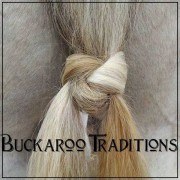
Visit Buckaroo Traiditons on Facebook


